Unit1 What's the matter?单元教学案(4课时)
文档属性
| 名称 | Unit1 What's the matter?单元教学案(4课时) | 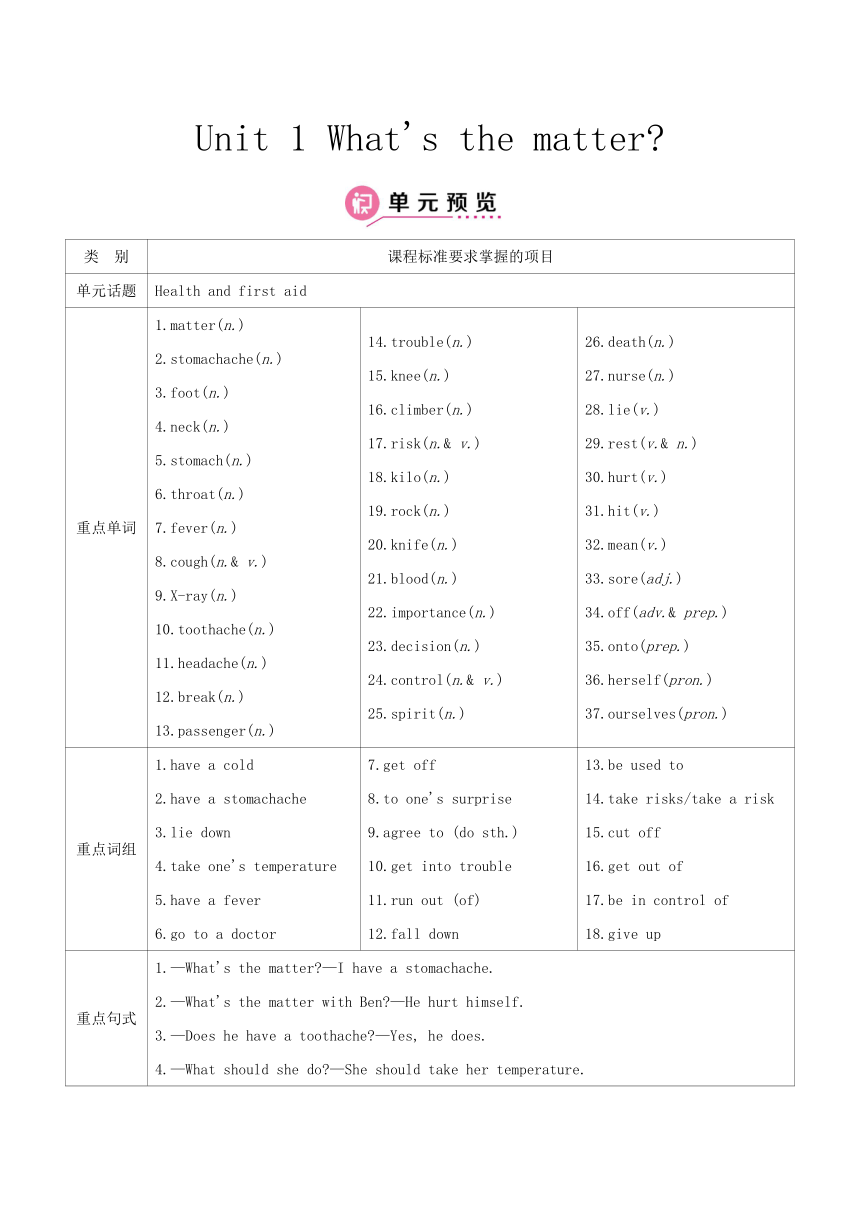 | |
| 格式 | docx | ||
| 文件大小 | 89.3KB | ||
| 资源类型 | 教案 | ||
| 版本资源 | 人教新目标(Go for it)版 | ||
| 科目 | 英语 | ||
| 更新时间 | 2021-04-14 12:56:18 | ||
图片预览

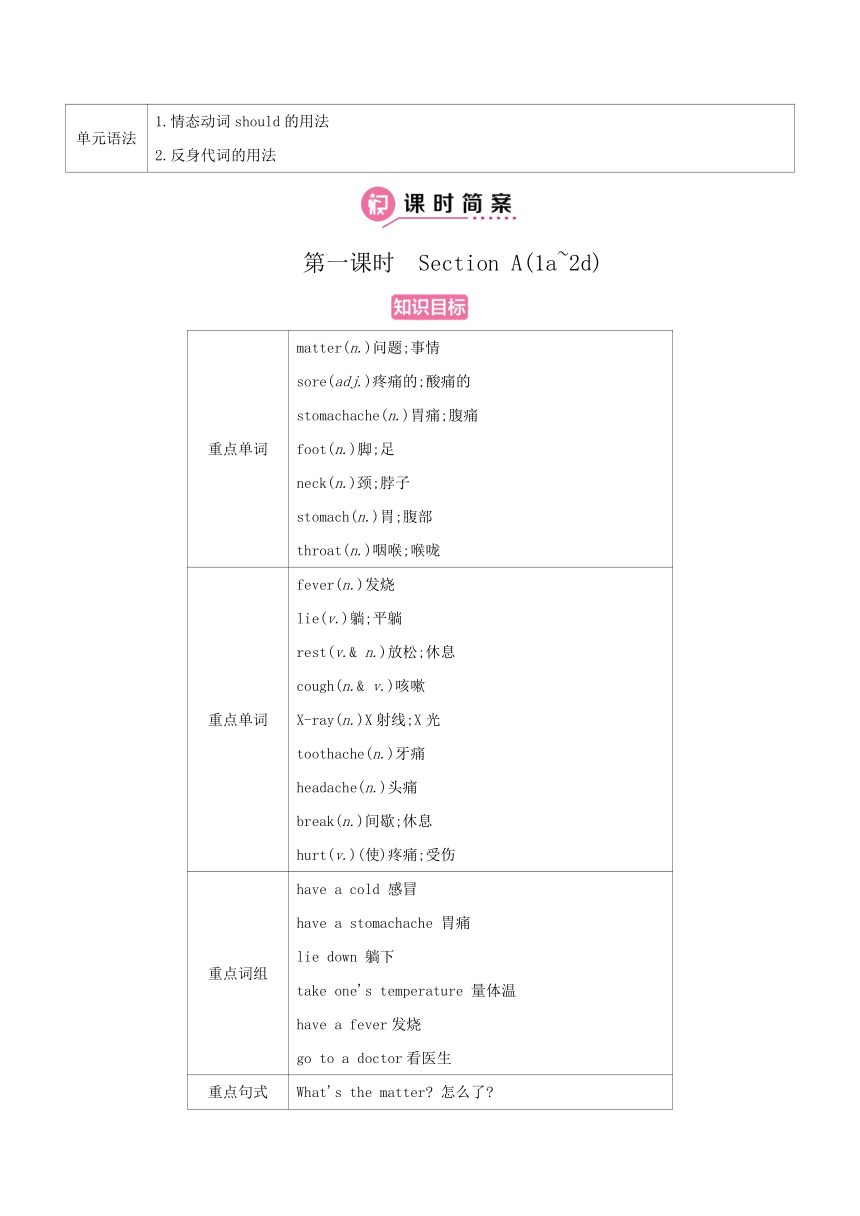
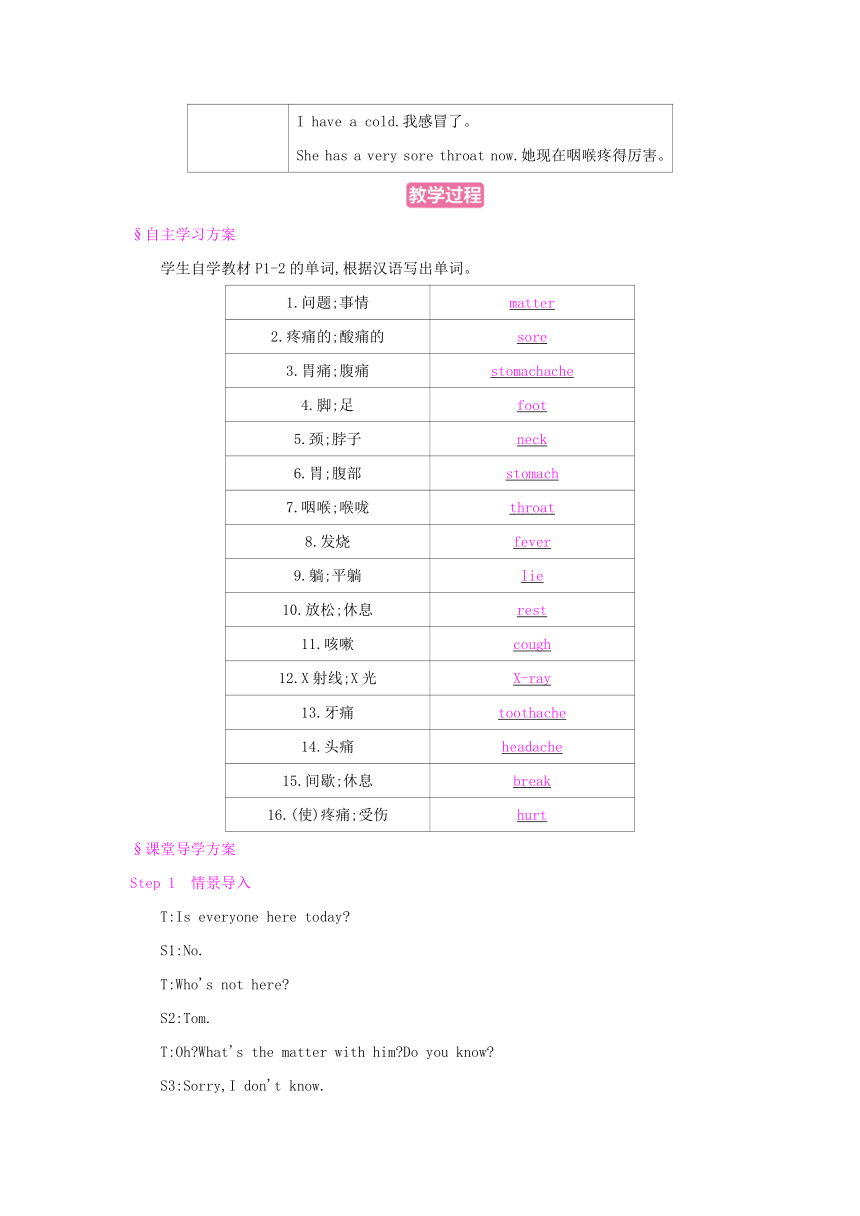
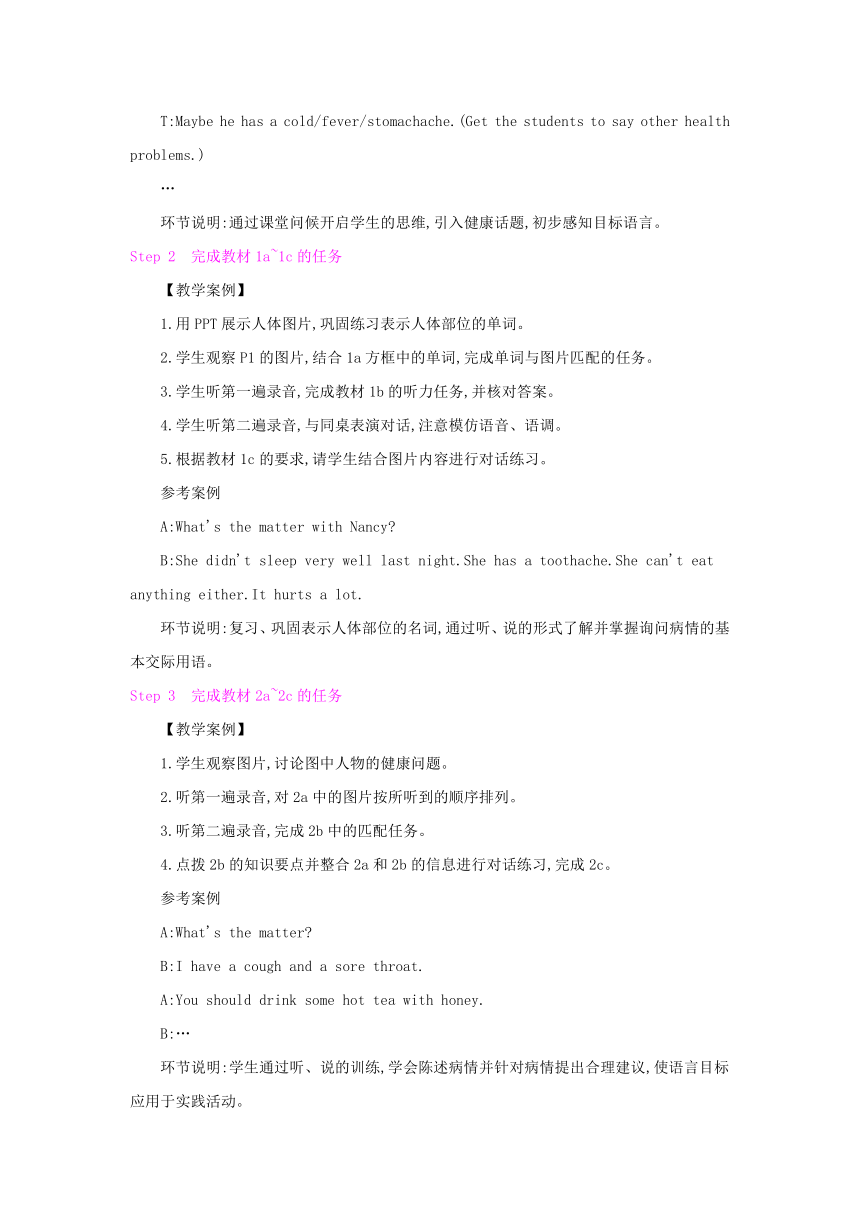
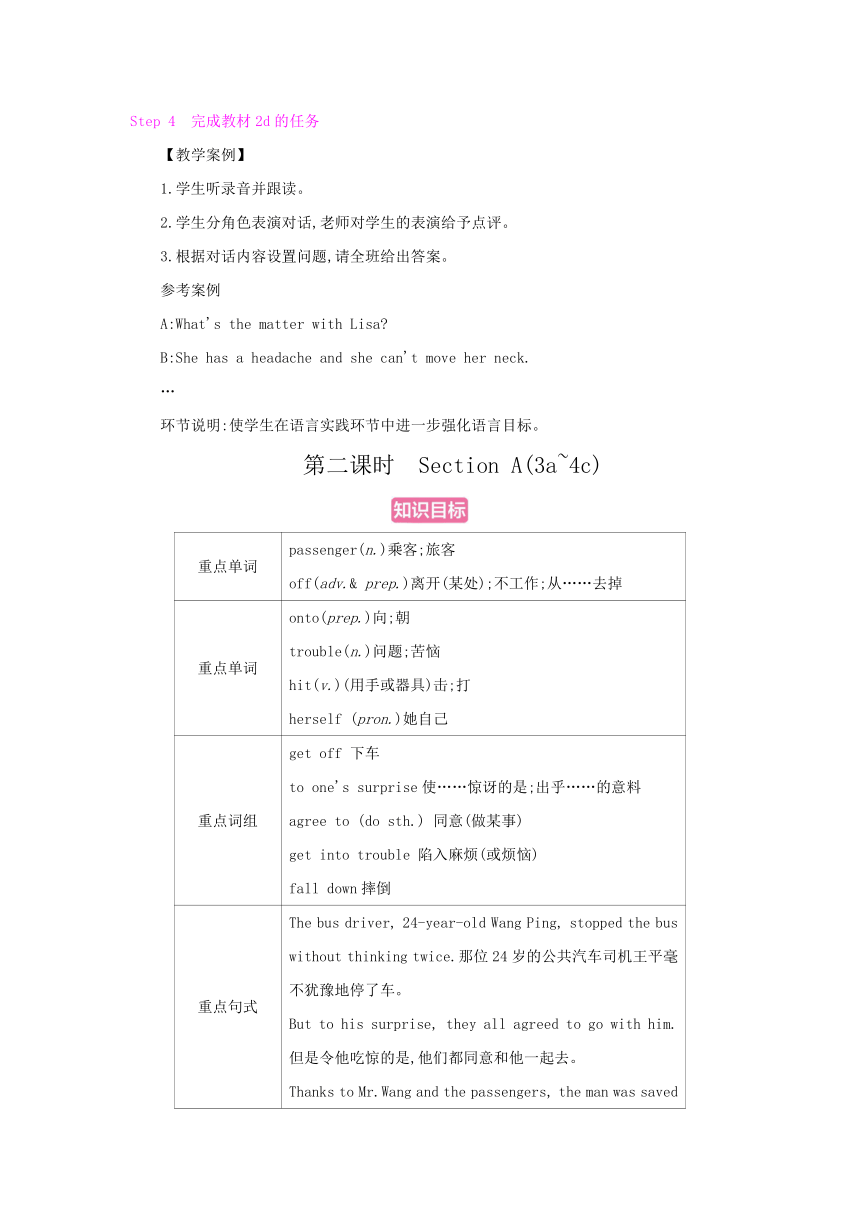
文档简介
Unit 1 What's the matter?
类 别
课程标准要求掌握的项目
单元话题
Health and first aid
重点单词
1.matter(n.)
2.stomachache(n.)
3.foot(n.)
4.neck(n.)
5.stomach(n.)
6.throat(n.)
7.fever(n.)
8.cough(n.& v.)
9.X-ray(n.)
10.toothache(n.)
11.headache(n.)
12.break(n.)
13.passenger(n.)
14.trouble(n.)
15.knee(n.)
16.climber(n.)
17.risk(n.& v.)
18.kilo(n.)
19.rock(n.)
20.knife(n.)
21.blood(n.)
22.importance(n.)
23.decision(n.)
24.control(n.& v.)
25.spirit(n.)
26.death(n.)
27.nurse(n.)
28.lie(v.)
29.rest(v.& n.)
30.hurt(v.)
31.hit(v.)
32.mean(v.)
33.sore(adj.)
34.off(adv.& prep.)
35.onto(prep.)
36.herself(pron.)
37.ourselves(pron.)
重点词组
1.have a cold
2.have a stomachache
3.lie down
4.take one's temperature
5.have a fever
6.go to a doctor
7.get off
8.to one's surprise
9.agree to (do sth.)
10.get into trouble
11.run out (of)
12.fall down
13.be used to
14.take risks/take a risk
15.cut off
16.get out of
17.be in control of
18.give up
重点句式
1.—What's the matter?—I have a stomachache.
2.—What's the matter with Ben?—He hurt himself.
3.—Does he have a toothache?—Yes, he does.
4.—What should she do?—She should take her temperature.
单元语法
1.情态动词should的用法
2.反身代词的用法
第一课时 Section A(1a~2d)
重点单词
matter(n.)问题;事情
sore(adj.)疼痛的;酸痛的
stomachache(n.)胃痛;腹痛
foot(n.)脚;足
neck(n.)颈;脖子
stomach(n.)胃;腹部
throat(n.)咽喉;喉咙
重点单词
fever(n.)发烧
lie(v.)躺;平躺
rest(v.& n.)放松;休息
cough(n.& v.)咳嗽
X-ray(n.)X射线;X光
toothache(n.)牙痛
headache(n.)头痛
break(n.)间歇;休息
hurt(v.)(使)疼痛;受伤
重点词组
have a cold 感冒
have a stomachache 胃痛
lie down 躺下
take one's temperature 量体温
have a fever发烧
go to a doctor看医生
重点句式
What's the matter? 怎么了?
I have a cold.我感冒了。
She has a very sore throat now.她现在咽喉疼得厉害。
§自主学习方案
学生自学教材P1-2的单词,根据汉语写出单词。
1.问题;事情
matter
2.疼痛的;酸痛的
sore
3.胃痛;腹痛
stomachache
4.脚;足
foot
5.颈;脖子
neck
6.胃;腹部
stomach
7.咽喉;喉咙
throat
8.发烧
fever
9.躺;平躺
lie
10.放松;休息
rest
11.咳嗽
cough
12.X射线;X光
X-ray
13.牙痛
toothache
14.头痛
headache
15.间歇;休息
break
16.(使)疼痛;受伤
hurt
§课堂导学方案
Step 1 情景导入
T:Is everyone here today?
S1:No.
T:Who's not here?
S2:Tom.
T:Oh?What's the matter with him?Do you know?
S3:Sorry,I don't know.
T:Maybe he has a cold/fever/stomachache.(Get the students to say other health problems.)
…
环节说明:通过课堂问候开启学生的思维,引入健康话题,初步感知目标语言。
Step 2 完成教材1a~1c的任务
【教学案例】
1.用PPT展示人体图片,巩固练习表示人体部位的单词。
2.学生观察P1的图片,结合1a方框中的单词,完成单词与图片匹配的任务。
3.学生听第一遍录音,完成教材1b的听力任务,并核对答案。
4.学生听第二遍录音,与同桌表演对话,注意模仿语音、语调。
5.根据教材1c的要求,请学生结合图片内容进行对话练习。
参考案例
A:What's the matter with Nancy?
B:She didn't sleep very well last night.She has a toothache.She can't eat anything either.It hurts a lot.
环节说明:复习、巩固表示人体部位的名词,通过听、说的形式了解并掌握询问病情的基本交际用语。
Step 3 完成教材2a~2c的任务
【教学案例】
1.学生观察图片,讨论图中人物的健康问题。
2.听第一遍录音,对2a中的图片按所听到的顺序排列。
3.听第二遍录音,完成2b中的匹配任务。
4.点拨2b的知识要点并整合2a和2b的信息进行对话练习,完成2c。
参考案例
A:What's the matter?
B:I have a cough and a sore throat.
A:You should drink some hot tea with honey.
B:…
环节说明:学生通过听、说的训练,学会陈述病情并针对病情提出合理建议,使语言目标应用于实践活动。
Step 4 完成教材2d的任务
【教学案例】
1.学生听录音并跟读。
2.学生分角色表演对话,老师对学生的表演给予点评。
3.根据对话内容设置问题,请全班给出答案。
参考案例
A:What's the matter with Lisa?
B:She has a headache and she can't move her neck.
…
环节说明:使学生在语言实践环节中进一步强化语言目标。
第二课时 Section A(3a~4c)
重点单词
passenger(n.)乘客;旅客
off(adv.& prep.)离开(某处);不工作;从……去掉
重点单词
onto(prep.)向;朝
trouble(n.)问题;苦恼
hit(v.)(用手或器具)击;打
herself (pron.)她自己
重点词组
get off 下车
to one's surprise使……惊讶的是;出乎……的意料
agree to (do sth.) 同意(做某事)
get into trouble 陷入麻烦(或烦恼)
fall down摔倒
重点句式
The bus driver, 24-year-old Wang Ping, stopped the bus without thinking twice.那位24岁的公共汽车司机王平毫不犹豫地停了车。
But to his surprise, they all agreed to go with him.但是令他吃惊的是,他们都同意和他一起去。
Thanks to Mr.Wang and the passengers, the man was saved by the doctors in time.多亏了王先生和乘客们,医生们及时救治了那个人。
§自主学习方案
学生自学教材P3-4的单词,根据音标写出单词。
§课堂导学方案
Step 1 情景导入
T:Look at the picture on Page 3.What happened in the picture?
S1:An old man was lying on the side of the road.
T:What should we do?
S2:We should call 120.
…
环节说明:设计情景,增强学生的好奇心,自然引入“救人”这一话题。
Step 2 完成教材3a~3c的任务
【教学案例】
1.学生浏览课文,研讨3a中提出的问题,鼓励学生各抒己见。
参考案例
T:Do you think it comes from a newspaper or a book?How do you know?
2.学生跟录音读课文,圈出自己有疑问的知识点。
3.学生精读课文,完成3b,并核对答案,采取组内讨论的方式解决知识问题。
4.小组成员讨论3c所列举的问题,达成共识后请代表发言,阐述小组的观点,老师给予点评。
环节说明:学生在任务的驱使下发展运用知识的能力。
Step 3 完成教材Grammar Focus的任务
【教学案例】
1.全体学生齐读语法句子。
2.两名学生配合完成任务:一名学生读句子,另一名学生负责翻译成汉语。
3.老师解释语言难点。
4.学生合上教材,完成下列句子练习。
根据汉语提示完成句子
①I have a stomachache.(胃疼)?
②What's the matter with Ben?(怎么了)?
③Do you have a fever?(发烧)?
④He should see a dentist(看牙医) and get an X-ray.(拍X光片)?
环节说明:循序渐进,从朗读到翻译,通过句子练习检测学生对重点句型的掌握情况。
Step 4 完成教材4a~4c的任务
【教学案例】
1.学生完成4a中的填空练习,并核对答案。
2.学生就4b中这些健康问题圈出最佳建议,并鼓励学生给出更多的合理化建议。
3.一位学生扮演病人,另一位学生根据他/她的动作表情猜测其病情并提出合理的建议。邀请多位学生展示,完成4c的任务。
参考案例
A:What's the matter? Did you hurt yourself playing soccer?
B:No, I didn't.
C:Did you fall down?
B:Yes, I did.
D:You should go home and get some rest.
环节说明:通过句子填空,写出建议练习,进一步巩固知识,提升学生运用知识的能力。
第三课时 Section B(1a~1d)
重点单词
bandage(n.)绷带 (v.)用绷带包扎
sick(adj.)生病的;有病的
knee(n.)膝;膝盖
nosebleed(n.)鼻出血
重点词组
go to the hospital去医院
get an X-ray 拍X光片
hurt oneself伤着自己
重点句式
Put a bandage on it.在上面缠上绷带。
Someone got hit on the head.某人撞到了头。
What happened? 发生了什么事?
§自主学习方案
学生自学教材P5的单词,写出单词的汉语意思。
1.bandage
绷带;用绷带包扎
2.sick
生病的;有病的
3.knee
膝;膝盖
4.nosebleed
鼻出血
§课堂导学方案
Step 1 情景导入
T:Did you have any accidents in your life?
S1:I fell down when I played soccer.
S2:I cut my finger when I was cooking.
S3:I had a nosebleed during the P.E. class yesterday.
…
T:What should you do with them?Now,let's look at the three pictures in 1a.
环节说明:创设贴近学生实际生活的情境,引入话题,为本课学习做准备。
Step 2 完成教材1a~1d的任务
1.学生观察1a中的图片,结合自己的生活经验排列句子排序。
2.核对答案,学生脱离教材回答老师的提问以巩固知识。
【教学案例】
T:What should you do if you have a nosebleed?
S:First,…Second,…Third,…
3.听第一遍录音,完成教材1b的任务,核对答案。
4.听第二遍录音,完成教材1c的任务,核对答案。
5.利用1b和1c的信息,学生扮演护士和老师并进行对话表演。
参考案例
A:Who came to your office today?
B:First, a boy came in.He hurt himself in P.E.class.
A:What happened?
B:He cut his knee.
…
环节说明:听、说、读任务的有机结合不仅巩固了目标语言,也锻炼了学生的语言综合运用能力。
第四课时 Section B(2a~Self Check)
重点单词
ourselves(pron.)我们自己
climber(n.)登山者;攀登者
risk(n.& v.)危险;风险;冒险
situation(n.)情况;状况
kilo(n.)千克;公斤
rock(n.)岩石
knife(n.)刀
blood(n.)血
mean(v.)意思是;打算,意欲
importance(n.)重要性;重要
decision(n.)决定;抉择
control(n. & v.)限制;约束;管理
spirit(n.)勇气;意志
death(n.)死;死亡
nurse(n.)护士
重点短语
be used to习惯于……;适应于……
take risks/take a risk冒险
run out (of) 用尽;耗尽
cut off切除
get out of离开;从……出来
be in control of掌管;管理
give up放弃
重点句式
Aron Ralston is an American man who is interested in mountain climbing.阿伦·罗尔斯顿是一个对登山感兴趣的美国人。
As a mountain climber, Aron is used to taking risks. 作为一名登山者,阿伦习惯于冒险。
In this book, Aron tells of the importance of making good decisions, and of being in control of one's life.在这本书中,阿伦讲述了做出好的决定以及掌控一个人的命运的重要性。
§自主学习方案
学生自学教材P6-8的单词,写出单词的汉语意思、变形形式或相关短语。
1.ourselves
我自己 myself
2.climber
v. climb
3.risk
冒险 take risks/take a risk
4.situation
n. 情况;状况
5.kilo
复数 kilos
6.rock
n. 岩石
7.knife
复数 knives
8.blood
n. 血
9.mean
n. meaning
10.importance
adj. important
11.decision
v. decide
12.control
掌管 be in control of
13.spirit
n. 勇气;意志
14.death
v. die
15.nurse
n. 护士
§课堂导学方案
Step 1 情景导入
T:Mountain climbing is an exciting but dangerous sport.Do you like climbing mountains? Do you think it's dangerous? Did you hurt yourself while playing sports?
S:…
环节说明:由登山运动导入新课,引发学生的兴趣,为下一步的学习做铺垫。
Step 2 完成教材2a~2e的任务
【教学案例】
1.学生根据生活常识完成2a的任务匹配,鼓励学生说出尽可能多的答案。
2.播放2b的短文录音,学生进行跟读训练,小组内练习大声朗读,请部分学生示范。
3.学生自读短文,阅读过程中如果有不认识的单词,查词典并记下它们的释义。
4.老师解答学生在阅读中自己无法解决的问题,以帮助学生全面理解文章。
5.学生完成2c正误的判定并核对答案。
6.学生再读一次短文并回答2d的问题。
7.学生完成2e的句子排序,并运用信息向同伴复述Aron的故事。
环节说明:学生在阅读过程中利用工具书解决问题,调动学生学习的积极性。
Step 3 完成教材3a~3b的任务
【教学案例】
1.两名学生分别扮演护士和一位有健康问题的学生并进行对话练习,其他学生记录下应该和不应该做的事情,完成3a。
参考案例
Accident or health
problem
He/She should
He/She shouldn't
have a sore back
lie down and rest
do sports
have a fever
take some medicine
exercise
have a sore throat
drink some hot tea
with honey
talk too much
have a toothache
see a dentist
stay up late
cut myself
put some medicine
on it
swim
2.利用3a中的信息,编写一段护士与学生间的对话并表演出来。
Nurse:What's the matter,young man?
Student:I have a fever.
Nurse:You should take some medicine and rest.
Student:Thanks.I will…
环节说明:通过编写对话这一输出过程在实际生活中应用目标语言。
Step 4 完成教材Self Check的任务
【教学案例】
1.把学生分为两组,其中一组学生在身体部位名词旁写出不同的健康问题,另一组成员给出相应的建议。
参考案例
Head:have a headache→have a good rest→go to a doctor
…
2.完成任务2中的排序练习,并请学生表演对话。
3.学生针对病情写出相应的建议并完成任务3。
环节说明:学生利用所学知识解决生活中的实际问题,体验成功感。
类 别
课程标准要求掌握的项目
单元话题
Health and first aid
重点单词
1.matter(n.)
2.stomachache(n.)
3.foot(n.)
4.neck(n.)
5.stomach(n.)
6.throat(n.)
7.fever(n.)
8.cough(n.& v.)
9.X-ray(n.)
10.toothache(n.)
11.headache(n.)
12.break(n.)
13.passenger(n.)
14.trouble(n.)
15.knee(n.)
16.climber(n.)
17.risk(n.& v.)
18.kilo(n.)
19.rock(n.)
20.knife(n.)
21.blood(n.)
22.importance(n.)
23.decision(n.)
24.control(n.& v.)
25.spirit(n.)
26.death(n.)
27.nurse(n.)
28.lie(v.)
29.rest(v.& n.)
30.hurt(v.)
31.hit(v.)
32.mean(v.)
33.sore(adj.)
34.off(adv.& prep.)
35.onto(prep.)
36.herself(pron.)
37.ourselves(pron.)
重点词组
1.have a cold
2.have a stomachache
3.lie down
4.take one's temperature
5.have a fever
6.go to a doctor
7.get off
8.to one's surprise
9.agree to (do sth.)
10.get into trouble
11.run out (of)
12.fall down
13.be used to
14.take risks/take a risk
15.cut off
16.get out of
17.be in control of
18.give up
重点句式
1.—What's the matter?—I have a stomachache.
2.—What's the matter with Ben?—He hurt himself.
3.—Does he have a toothache?—Yes, he does.
4.—What should she do?—She should take her temperature.
单元语法
1.情态动词should的用法
2.反身代词的用法
第一课时 Section A(1a~2d)
重点单词
matter(n.)问题;事情
sore(adj.)疼痛的;酸痛的
stomachache(n.)胃痛;腹痛
foot(n.)脚;足
neck(n.)颈;脖子
stomach(n.)胃;腹部
throat(n.)咽喉;喉咙
重点单词
fever(n.)发烧
lie(v.)躺;平躺
rest(v.& n.)放松;休息
cough(n.& v.)咳嗽
X-ray(n.)X射线;X光
toothache(n.)牙痛
headache(n.)头痛
break(n.)间歇;休息
hurt(v.)(使)疼痛;受伤
重点词组
have a cold 感冒
have a stomachache 胃痛
lie down 躺下
take one's temperature 量体温
have a fever发烧
go to a doctor看医生
重点句式
What's the matter? 怎么了?
I have a cold.我感冒了。
She has a very sore throat now.她现在咽喉疼得厉害。
§自主学习方案
学生自学教材P1-2的单词,根据汉语写出单词。
1.问题;事情
matter
2.疼痛的;酸痛的
sore
3.胃痛;腹痛
stomachache
4.脚;足
foot
5.颈;脖子
neck
6.胃;腹部
stomach
7.咽喉;喉咙
throat
8.发烧
fever
9.躺;平躺
lie
10.放松;休息
rest
11.咳嗽
cough
12.X射线;X光
X-ray
13.牙痛
toothache
14.头痛
headache
15.间歇;休息
break
16.(使)疼痛;受伤
hurt
§课堂导学方案
Step 1 情景导入
T:Is everyone here today?
S1:No.
T:Who's not here?
S2:Tom.
T:Oh?What's the matter with him?Do you know?
S3:Sorry,I don't know.
T:Maybe he has a cold/fever/stomachache.(Get the students to say other health problems.)
…
环节说明:通过课堂问候开启学生的思维,引入健康话题,初步感知目标语言。
Step 2 完成教材1a~1c的任务
【教学案例】
1.用PPT展示人体图片,巩固练习表示人体部位的单词。
2.学生观察P1的图片,结合1a方框中的单词,完成单词与图片匹配的任务。
3.学生听第一遍录音,完成教材1b的听力任务,并核对答案。
4.学生听第二遍录音,与同桌表演对话,注意模仿语音、语调。
5.根据教材1c的要求,请学生结合图片内容进行对话练习。
参考案例
A:What's the matter with Nancy?
B:She didn't sleep very well last night.She has a toothache.She can't eat anything either.It hurts a lot.
环节说明:复习、巩固表示人体部位的名词,通过听、说的形式了解并掌握询问病情的基本交际用语。
Step 3 完成教材2a~2c的任务
【教学案例】
1.学生观察图片,讨论图中人物的健康问题。
2.听第一遍录音,对2a中的图片按所听到的顺序排列。
3.听第二遍录音,完成2b中的匹配任务。
4.点拨2b的知识要点并整合2a和2b的信息进行对话练习,完成2c。
参考案例
A:What's the matter?
B:I have a cough and a sore throat.
A:You should drink some hot tea with honey.
B:…
环节说明:学生通过听、说的训练,学会陈述病情并针对病情提出合理建议,使语言目标应用于实践活动。
Step 4 完成教材2d的任务
【教学案例】
1.学生听录音并跟读。
2.学生分角色表演对话,老师对学生的表演给予点评。
3.根据对话内容设置问题,请全班给出答案。
参考案例
A:What's the matter with Lisa?
B:She has a headache and she can't move her neck.
…
环节说明:使学生在语言实践环节中进一步强化语言目标。
第二课时 Section A(3a~4c)
重点单词
passenger(n.)乘客;旅客
off(adv.& prep.)离开(某处);不工作;从……去掉
重点单词
onto(prep.)向;朝
trouble(n.)问题;苦恼
hit(v.)(用手或器具)击;打
herself (pron.)她自己
重点词组
get off 下车
to one's surprise使……惊讶的是;出乎……的意料
agree to (do sth.) 同意(做某事)
get into trouble 陷入麻烦(或烦恼)
fall down摔倒
重点句式
The bus driver, 24-year-old Wang Ping, stopped the bus without thinking twice.那位24岁的公共汽车司机王平毫不犹豫地停了车。
But to his surprise, they all agreed to go with him.但是令他吃惊的是,他们都同意和他一起去。
Thanks to Mr.Wang and the passengers, the man was saved by the doctors in time.多亏了王先生和乘客们,医生们及时救治了那个人。
§自主学习方案
学生自学教材P3-4的单词,根据音标写出单词。
§课堂导学方案
Step 1 情景导入
T:Look at the picture on Page 3.What happened in the picture?
S1:An old man was lying on the side of the road.
T:What should we do?
S2:We should call 120.
…
环节说明:设计情景,增强学生的好奇心,自然引入“救人”这一话题。
Step 2 完成教材3a~3c的任务
【教学案例】
1.学生浏览课文,研讨3a中提出的问题,鼓励学生各抒己见。
参考案例
T:Do you think it comes from a newspaper or a book?How do you know?
2.学生跟录音读课文,圈出自己有疑问的知识点。
3.学生精读课文,完成3b,并核对答案,采取组内讨论的方式解决知识问题。
4.小组成员讨论3c所列举的问题,达成共识后请代表发言,阐述小组的观点,老师给予点评。
环节说明:学生在任务的驱使下发展运用知识的能力。
Step 3 完成教材Grammar Focus的任务
【教学案例】
1.全体学生齐读语法句子。
2.两名学生配合完成任务:一名学生读句子,另一名学生负责翻译成汉语。
3.老师解释语言难点。
4.学生合上教材,完成下列句子练习。
根据汉语提示完成句子
①I have a stomachache.(胃疼)?
②What's the matter with Ben?(怎么了)?
③Do you have a fever?(发烧)?
④He should see a dentist(看牙医) and get an X-ray.(拍X光片)?
环节说明:循序渐进,从朗读到翻译,通过句子练习检测学生对重点句型的掌握情况。
Step 4 完成教材4a~4c的任务
【教学案例】
1.学生完成4a中的填空练习,并核对答案。
2.学生就4b中这些健康问题圈出最佳建议,并鼓励学生给出更多的合理化建议。
3.一位学生扮演病人,另一位学生根据他/她的动作表情猜测其病情并提出合理的建议。邀请多位学生展示,完成4c的任务。
参考案例
A:What's the matter? Did you hurt yourself playing soccer?
B:No, I didn't.
C:Did you fall down?
B:Yes, I did.
D:You should go home and get some rest.
环节说明:通过句子填空,写出建议练习,进一步巩固知识,提升学生运用知识的能力。
第三课时 Section B(1a~1d)
重点单词
bandage(n.)绷带 (v.)用绷带包扎
sick(adj.)生病的;有病的
knee(n.)膝;膝盖
nosebleed(n.)鼻出血
重点词组
go to the hospital去医院
get an X-ray 拍X光片
hurt oneself伤着自己
重点句式
Put a bandage on it.在上面缠上绷带。
Someone got hit on the head.某人撞到了头。
What happened? 发生了什么事?
§自主学习方案
学生自学教材P5的单词,写出单词的汉语意思。
1.bandage
绷带;用绷带包扎
2.sick
生病的;有病的
3.knee
膝;膝盖
4.nosebleed
鼻出血
§课堂导学方案
Step 1 情景导入
T:Did you have any accidents in your life?
S1:I fell down when I played soccer.
S2:I cut my finger when I was cooking.
S3:I had a nosebleed during the P.E. class yesterday.
…
T:What should you do with them?Now,let's look at the three pictures in 1a.
环节说明:创设贴近学生实际生活的情境,引入话题,为本课学习做准备。
Step 2 完成教材1a~1d的任务
1.学生观察1a中的图片,结合自己的生活经验排列句子排序。
2.核对答案,学生脱离教材回答老师的提问以巩固知识。
【教学案例】
T:What should you do if you have a nosebleed?
S:First,…Second,…Third,…
3.听第一遍录音,完成教材1b的任务,核对答案。
4.听第二遍录音,完成教材1c的任务,核对答案。
5.利用1b和1c的信息,学生扮演护士和老师并进行对话表演。
参考案例
A:Who came to your office today?
B:First, a boy came in.He hurt himself in P.E.class.
A:What happened?
B:He cut his knee.
…
环节说明:听、说、读任务的有机结合不仅巩固了目标语言,也锻炼了学生的语言综合运用能力。
第四课时 Section B(2a~Self Check)
重点单词
ourselves(pron.)我们自己
climber(n.)登山者;攀登者
risk(n.& v.)危险;风险;冒险
situation(n.)情况;状况
kilo(n.)千克;公斤
rock(n.)岩石
knife(n.)刀
blood(n.)血
mean(v.)意思是;打算,意欲
importance(n.)重要性;重要
decision(n.)决定;抉择
control(n. & v.)限制;约束;管理
spirit(n.)勇气;意志
death(n.)死;死亡
nurse(n.)护士
重点短语
be used to习惯于……;适应于……
take risks/take a risk冒险
run out (of) 用尽;耗尽
cut off切除
get out of离开;从……出来
be in control of掌管;管理
give up放弃
重点句式
Aron Ralston is an American man who is interested in mountain climbing.阿伦·罗尔斯顿是一个对登山感兴趣的美国人。
As a mountain climber, Aron is used to taking risks. 作为一名登山者,阿伦习惯于冒险。
In this book, Aron tells of the importance of making good decisions, and of being in control of one's life.在这本书中,阿伦讲述了做出好的决定以及掌控一个人的命运的重要性。
§自主学习方案
学生自学教材P6-8的单词,写出单词的汉语意思、变形形式或相关短语。
1.ourselves
我自己 myself
2.climber
v. climb
3.risk
冒险 take risks/take a risk
4.situation
n. 情况;状况
5.kilo
复数 kilos
6.rock
n. 岩石
7.knife
复数 knives
8.blood
n. 血
9.mean
n. meaning
10.importance
adj. important
11.decision
v. decide
12.control
掌管 be in control of
13.spirit
n. 勇气;意志
14.death
v. die
15.nurse
n. 护士
§课堂导学方案
Step 1 情景导入
T:Mountain climbing is an exciting but dangerous sport.Do you like climbing mountains? Do you think it's dangerous? Did you hurt yourself while playing sports?
S:…
环节说明:由登山运动导入新课,引发学生的兴趣,为下一步的学习做铺垫。
Step 2 完成教材2a~2e的任务
【教学案例】
1.学生根据生活常识完成2a的任务匹配,鼓励学生说出尽可能多的答案。
2.播放2b的短文录音,学生进行跟读训练,小组内练习大声朗读,请部分学生示范。
3.学生自读短文,阅读过程中如果有不认识的单词,查词典并记下它们的释义。
4.老师解答学生在阅读中自己无法解决的问题,以帮助学生全面理解文章。
5.学生完成2c正误的判定并核对答案。
6.学生再读一次短文并回答2d的问题。
7.学生完成2e的句子排序,并运用信息向同伴复述Aron的故事。
环节说明:学生在阅读过程中利用工具书解决问题,调动学生学习的积极性。
Step 3 完成教材3a~3b的任务
【教学案例】
1.两名学生分别扮演护士和一位有健康问题的学生并进行对话练习,其他学生记录下应该和不应该做的事情,完成3a。
参考案例
Accident or health
problem
He/She should
He/She shouldn't
have a sore back
lie down and rest
do sports
have a fever
take some medicine
exercise
have a sore throat
drink some hot tea
with honey
talk too much
have a toothache
see a dentist
stay up late
cut myself
put some medicine
on it
swim
2.利用3a中的信息,编写一段护士与学生间的对话并表演出来。
Nurse:What's the matter,young man?
Student:I have a fever.
Nurse:You should take some medicine and rest.
Student:Thanks.I will…
环节说明:通过编写对话这一输出过程在实际生活中应用目标语言。
Step 4 完成教材Self Check的任务
【教学案例】
1.把学生分为两组,其中一组学生在身体部位名词旁写出不同的健康问题,另一组成员给出相应的建议。
参考案例
Head:have a headache→have a good rest→go to a doctor
…
2.完成任务2中的排序练习,并请学生表演对话。
3.学生针对病情写出相应的建议并完成任务3。
环节说明:学生利用所学知识解决生活中的实际问题,体验成功感。
同课章节目录
- Unit 1 What's the matter?
- Section A
- Section B
- Unit 2 I'll help to clean up the city parks.
- Section A
- Section B
- Unit 3 Could you please clean your room?
- Section A
- Section B
- Unit 4 Why don't you talk to your parents?
- Section A
- Section B
- Unit 5 What were you doing when the rainstorm came
- Section A
- Section B
- Review of Units 1-5
- Unit 6 An old man tried to move the mountains.
- Section A
- Section B
- Unit 7 What's the highest mountain in the world?
- Section A
- Section B
- Unit 8 Have you read Treasure Island yet?
- Section A
- Section B
- Unit 9 Have you ever been to a museum?
- Section A
- Section B
- Unit 10 I've had this bike for three years.
- Section A
- Section B
